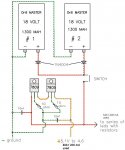newplumber
Senior Member
Hello to everyone and yes even you
I was going to build another remote led sign that after computing all the power usage and testing
I came up with 310 mill amps on the 18 volt side
and no more then 100 mill amps on the 5 volts side which would run the picaxe and mosfets but to add just in case I added on my schematic 400 mA for 18 volt and 200 for 5v mA
Since this plan does work (from me testing only 1 battery) and nothing is heating up , everythings cold, my question is can I have those diodes on the positive side because I am going to recharge those batterys
one at a time and will it stop the batterys from heating up trying to equalize? (which i have not yet tried)
Example is if you have one battery 90% charged and one 40% charged in my theory without silicone diodes the 90% would rush into the 40% to equal which may cause overheating
I know my schematic is not right because i designed it ,but with two power regulators I was hoping it helps keep them cool
The reason why I put resistors on the middle pins is because at 18 volts (which is the highest these batterys can charge) it gives me 5.1 volts on the L7805
and when the batterys are drawn down to about 8.5 volts the L7805 reads about 4.8 volts so I was trying to keep the voltage as close to 5 no matter what the batterys voltage is
I know the picaxe 20m2 can run down to <3v
I can easily redo this schematic with a better plan if anyone has any thought
Thanks again forums "if this thread isn't proper for forums then sorry delete thread"
Your last friend on the list
I was going to build another remote led sign that after computing all the power usage and testing
I came up with 310 mill amps on the 18 volt side
and no more then 100 mill amps on the 5 volts side which would run the picaxe and mosfets but to add just in case I added on my schematic 400 mA for 18 volt and 200 for 5v mA
Since this plan does work (from me testing only 1 battery) and nothing is heating up , everythings cold, my question is can I have those diodes on the positive side because I am going to recharge those batterys
one at a time and will it stop the batterys from heating up trying to equalize? (which i have not yet tried)
Example is if you have one battery 90% charged and one 40% charged in my theory without silicone diodes the 90% would rush into the 40% to equal which may cause overheating
I know my schematic is not right because i designed it ,but with two power regulators I was hoping it helps keep them cool
The reason why I put resistors on the middle pins is because at 18 volts (which is the highest these batterys can charge) it gives me 5.1 volts on the L7805
and when the batterys are drawn down to about 8.5 volts the L7805 reads about 4.8 volts so I was trying to keep the voltage as close to 5 no matter what the batterys voltage is
I know the picaxe 20m2 can run down to <3v
I can easily redo this schematic with a better plan if anyone has any thought
Thanks again forums "if this thread isn't proper for forums then sorry delete thread"
Your last friend on the list
Attachments
-
100.4 KB Views: 49


